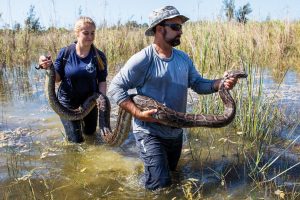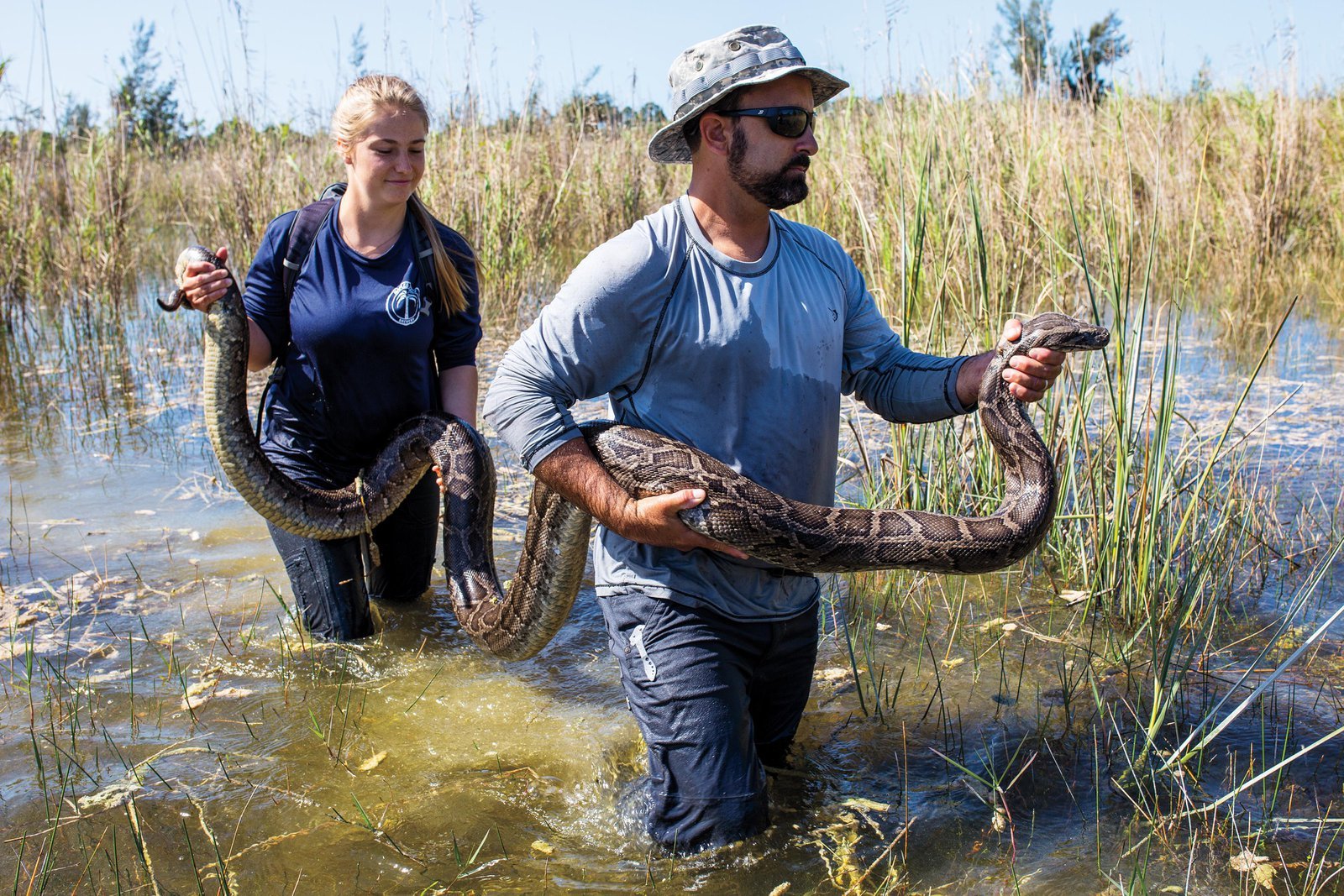 By: Jessica Rooke
By: Jessica Rooke
Florida is considered to be the invasive species hotspot. Native to Southeast Asia, Burmese pythons are an exotic (nonnative) species in South Florida. They are also an invasive species, which means that they are not constrained by natural factors as much as they were in their native habitat.[1] Invasive species have the potential to harm their new environments. As a matter of fact, the threat invasive species pose is second only to the direct destruction of habitats through development.[2]
Invasive species typically make their way into the United States through the pet trade. When the owners of the unusual, exotic pets realize that their pet requires more work than a normal pet such as a cat or dog, pet owners tend to panic and do what they do with trash: simply throw it away somewhere and forget about it. The issue with trash is that it can pile up and have effects on nature and the ecosystem. The Burmese python is one such animal that humans tend to simply “throw” away and try to forget about. Unable to handle their giant snakes and unable to find new homes for them, some owners illegally release them into the wild.[3] These snakes also have made their way into the Florida ecosystem through the wreckage of some of the most notable hurricanes in the United States, such as Hurricane Andrew.[4] Overall, data points to the fact that from early 2000 to present day, the population of breeding pythons in the Everglades has spiraled to well over 30,000. Because pythons live 25 years or more and females can lay up to 87 eggs per year, these reptiles will continue to exponentially take over the Everglades.[5]
One direct effect Pythons are having on the Everglades is on the mammal population within Florida’s native wildlife. In essence, they are nearly completely decimating the population of various native mammals. A study conducted by Michael Dorcas, a herpetologist at Davidson College in North Carolina in 2011, documented “severe declines” in mammal sightings.[6] The 2003 to 2011 surveys compared mammal sightings to data from surveys conducted in 1996 and 1997 – before the python was breeding in the wild.[7] As the population of pythons has spiraled upwards in the last two decades, populations of raccoons have dropped 99.3 percent; opossums 98.9 percent; bobcats 87.5 percent since 1997; and marsh rabbits, cottontail rabbits, and foxes effectively have disappeared.[8] The above-listed mammals simply have no instinctive defense or fear from a large carnivorous snake like the python. This is because before the Burmese Python was introduced in the early 2000s, the last large snake to live in this region was 16 million years ago; this is when a boa-like snake became extinct.[9] As a result, these mammals have become easy prey. If 30,000+ pythons are presently causing 90+% declines in the population of native mammalian life, then this level of growth appears completely unsustainable. Food sources will simply run out. Native species will go extinct.
While no one law addresses all the concerns of invasive species, many federal laws address aspects of invasive species. These laws include the Lacey Act, which has a provision to curtail the introduction of injurious species.[10] As well as Executive Order 13112 which created the National Invasive Species Council and the Invasive Species Advisory Committee, which work together with stakeholders, concerned members of the public, and member departments to address invasive species.[11] Florida law also attempts to address this problem by putting Burmese pythons on the list of prohibited species, ridding protection under anti-cruelty laws for these reptiles, and creating various programs such as the Exotic Pet Amnesty Program and the Python Bounty Challenges.[12]
Nonetheless, a fundamental flaw exists with Florida’s proposed attempt at containment. Reducing the population of pythons decreases the competition for remaining food resources. As a result, the pythons that do remain become healthier, stronger, and more fertile.[13] And in the end, the population continues to grow at high rates; thus, decreasing the population in the short-term will actually cause it to spike in the long-term. Florida must seek a different approach to adequately combat the python issue.
No reliable alternatives exist besides complete removal. And as the snakes spread along the southeastern coast eating the mammal populations in Florida until they are completely extinct, this problem has the potential to expand beyond Florida. Preventing the spread of these animals is an enormously challenging undertaking that Florida has grappled with for decades. Their fragmented, incomplete approach has yet to prove effective. At this point, Florida must take a more holistic approach, filling in the gaps where they have fallen short, in an attempt to eradicate the python population. Obviously, this is a monumentally challenging undertaking, but considering the effect this species is having on the ecosystem it is at least worth trying.
[1] Rebecca G. Harvey et. al, Burmese Pythons in South Florida, Univ. of Fla. (2008)
https://crocdoc.ifas.ufl.edu/publications/factsheets/Burmese%20pythons%20in%20S%20FL_IFAS%20factsheet_fin al_NPS.pdf.
[2] Id.
[3] Id.
[4] Christian Capehart et al., Burmese Pythons, Univ. of Okla. (2018)
https://shareok.org/bitstream/handle/11244/317115/Pythons.pdf?sequence=1&isAllowed=y.
[5] Michael Sarill, Burmese Pythons in the Everglades, Berkeley Int’l & Exec. Program (2016) https://iep.berkeley.edu/content/burmese-pythons-everglades.
[6] Id.
[7] Id.
[8] Id.
[9] Id.
[10] 16 U.S. Code § 3372 (1900).
[11] Exec. Order No. 13112, 1999 WL 54572 (1999).
[12] Fla. Admin. Code R. 68-5.006; Florida Fish and Wildlife Conservation Commission, Burmese Python Fast Facts,
https://myfwc.com/wildlifehabitats/nonnatives/python/fast-facts/ (last visited on Dec. 3, 2021).; Karl Schneider, Florida python hunters didn’t miss a break during the pandemic- they’re breaking records, USA Today (2020)
https://www.usatoday.com/story/news/nation/2020/11/16/python-hunters-break-records-after-state-agencies-combine -forces/6316389002/; Fla. Admin. Code R. 68-5.008.
[13] The Nature Conservancy, Stopping the spread of invasive species in Florida, (2018),
https://www.nature.org/en-us/about-us/where-we-work/united-states/florida/stories-in-florida/combating-invasive-sp ecies-in-florida/.
